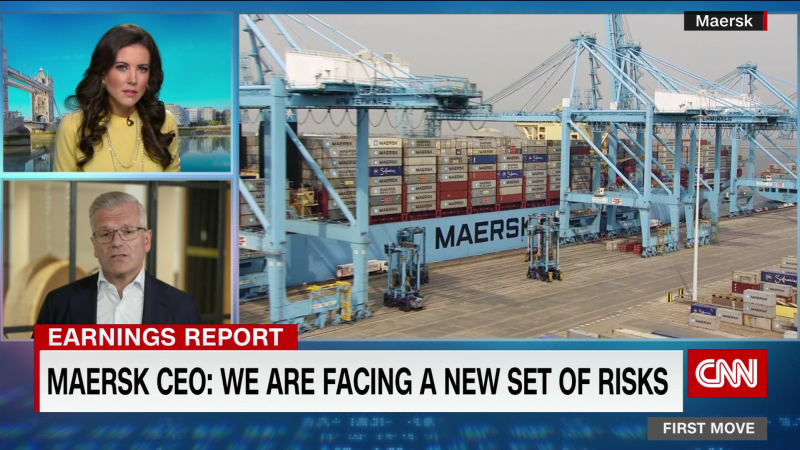Belden Inc. (NYSE:BDC) Q3 2023 Earnings Conference Call November 2, 2023 8:30 AM ET
Company Participants
Aaron Reddington – Vice President-Investor Relations
Ashish Chand – President & Chief Executive Officer
Jeremy Parks – Senior Vice President & Chief Financial Officer
Conference Call Participants
William Stein – Truist Securities
Rob Jamieson – UBS
Mark Delaney – Goldman Sachs
Reuben Garner – Benchmark Company
Steven Fox – Fox Advisors
Operator
Ladies and gentlemen, thank you for standing by. Welcome to this morning’s Belden reports Third Quarter 2023 Results Call. Just a reminder, this call is being recorded. At this time, you’re in a listen-only mode. Later, we will conduct a question-and-answer session. [Operator Instructions]
I would now like to turn the call over to Aaron Reddington, Vice President of Investor Relations. Please go ahead, sir.
Aaron Reddington
Thank you. Good morning everyone, and thank you for joining us for Belden’s Third Quarter 2023 Earnings Conference Call. With me today are Belden’s President and CEO, Ashish Chand; and Senior Vice President and CFO, Jeremy Parks. Ashish will provide a strategic overview of our business, and then Jeremy will provide a detailed review of our financial and operating results, followed by Q&A. We issued our earnings release earlier this morning and have prepared a slide presentation that we will reference on this call. The press release, presentation and transcript of these prepared remarks are currently available online at investor.belden.com.
Turning to slide two in the presentation. During this call, management will make certain forward-looking statements. For more information, please review today’s press release and our most recent annual report on Form 10-K. Additionally, during today’s call, management will reference adjusted or non-GAAP financial information. In accordance with Regulation G, the appendix to our presentation and the investor relations section of our website contains a reconciliation of the most closely associated GAAP financial information to the non-GAAP financial information we communicate.
I will now turn the call over to our President and CEO, Ashish Chand.
Ashish Chand
Thank you, Aaron, and good morning everyone. We appreciate you joining us today. As highlighted in our communication three weeks ago, third quarter results were below our expectations, as demand unexpectedly weakened within our industrial and broadband markets adding to ongoing pressure from channel destocking.
Despite a softening in demand, our expanding solutions-driven mix drove gross margin outperformance, resulting in Belden achieving the lower end of our initial adjusted EPS outlook. Our proactive efforts towards becoming a premier solutions provider continue, even amid the current market weakness. We believe this approach will drive incremental growth and margin expansion over the long term.
In the meantime, we are evaluating opportunities to protect margin where appropriate and have already taken cost saving measures in response to the market weakness. Furthermore, we remain confident in the resilience of our portfolio, which stands well-positioned to benefit from significant secular trends with lengthy investment cycles.
Now, let’s review the quarter. Please turn to slide four for a summary of the third quarter of 2023. As a reminder, I’ll be referring to adjusted results today. Our team performed admirably, considering the difficult operating backdrop. Unfortunately, industry demand weakness came about unexpectedly and we experienced a marked change in orders in our Industrial and Broadband markets during the quarter. After growing orders 4% sequentially in the second quarter, total orders were down 19% sequentially in the third quarter.
As such, we achieved quarterly revenue of $627 million, down 7% year over year. Despite end demand softness, our shift to solution sales continues, which led to favorable margins during the period. Gross margins were up 280 basis points to 39% and EBITDA margins were up 80 basis points to 18.4%.
Organic growth was down 4% in our Industrial Automation Segment with EBITDA margins up 230 basis points to 22.5%. In Enterprise Solutions, organic growth was down 14% with EBITDA margins down 110 basis points. As we adjust to this temporary weakness, we expect to continue to follow our previously outlined capital allocation priorities with organic growth as our top priority, followed by M&A, and finally returning capital to shareholders.
Our balance sheet is strong with ample liquidity, and leverage at Belden remains low at 1.3 times, down from 1.4 times in the prior quarter. We have significant financial flexibility to execute upon our strategic plans, whilst staying around our targeted net leverage ratio of 1.5 times, even if the outlook becomes more challenging.
Free cash flow for the quarter was robust, and we continued to deploy capital to grow the business. I am pleased to report that year-to-date we have invested nearly $110 million in M&A, with our most recent acquisition of CloudRail, an edge software provider that helps connect and manage devices in industrial environments. Welcome to the team CloudRail.
Further, year-to-date, we have returned over $150 million to shareholders.
In summary, the unexpected shifts in market demand in industrial and broadband during the third quarter impacted orders. That being said, our team executed well and we are proud to have sustained these healthy levels of profitability with such a strong balance sheet and cash flow position.
Now please turn to slide 5 for a summary of our market performance in the third quarter and where we see things trending over the short-term. Taking a step back, during the third quarter orders changed considerably in our industrial and broadband markets. Smart Buildings performed as expected, but was more than offset by the sequential change in orders in our other markets.
Starting with the Industrial Automation market. The first half of the year our business performed well with orders roughly flat sequentially in the second quarter and point-of-sale data confirming our order trends. As the third quarter progressed, industrial customers became increasingly cautious and we saw a material change in our orders and point-of-sale data.
On a sequential basis, our industrial orders for the third quarter were down 21%. The softness in the industrial market has many contributing factors, but at a high level the weakness in orders has two major drivers. First, we experienced a pause in end customer demand due to broad weakness in discrete manufacturing. Second, both OEMs and distributors took action to further reduce inventory levels during the quarter. The smart change in demand for industrial automation products and solutions is a temporary reaction coming into the back half of 2023 amid overall macro uncertainties.
Looking forward, we expect to see reduced demand for a few quarters as end users adjust to challenges in the marketplace. However, we expect them to emerge with continued investments in automation.
Longer term our secular trends remain intact led by reshoring, labor shortages and investments in Industrial Automation. I’m confident that we are well-positioned to grow market share once we get past this temporary slowdown.
In the Smart Buildings market, we saw revenue and orders more or less in line with our guidance. Within smart buildings, we experienced weakness in commercial real estate with more stability in our targeted verticals such as hospitality and government.
The smart building market continues to face challenges with higher interest rates creating uncertainty and distributors continuing to destock as they adjust to lower demand and work to improve cash flow. Similar to our industrial market point-of-sales data declined in the third quarter which points to further weakness into the fourth quarter and 2024.
Longer term, we expect to see demand growth from increasing digitization and expanding connectivity needs. Our customers have increasingly complex challenges including hybrid networks that combine disparate data and network protocols onto a single backbone. Belden is well-positioned to address these challenges with our product breadth and technical expertise.
Finally in the Broadband Solutions market, we had a good first half of the year with meaningful order growth in the second quarter. However, in the third quarter we experienced a sharp reversal with orders down 28% sequentially. This change in the third quarter is the result of MSOs adjusting their procurement processes to reduce inventory and rely on shorter lead times to meet demand.
Planned network upgrades remain intact. However, we anticipate a soft fourth quarter as customers further adjust inventory into year end. We expect a pick up in orders as we move through the first half of 2024 with further momentum as government funding increases throughout next year.
I will now request Jeremy to provide additional insight into our third quarter financial performance.
Jeremy Parks
Thank you, Ashish. I will start my comments with results for the third quarter followed by a review of our segment results, a discussion of the balance sheet and cash flow performance, and finally our outlook. As a reminder, I will be referencing adjusted results today.
Now please turn to slide 6 in our presentation for a review of our third quarter results. Third quarter revenue decreased 7% year-over-year and was down 9% organically to $627 million exceeding our preliminary view of $625 million. We experienced softness in Industrial Automation with revenues decreasing 4% organically.
Longer term, we continue to see compelling secular demand drivers for automation solutions as industrial customers respond to labor shortages, capacity requirements and the reshoring of production. Enterprise Solutions revenue decreased 14% organically with increased weakness in our Broadband Solutions market. As Ashish mentioned earlier, orders for the third quarter were down 19% sequentially with weakness in both segments. We ended the quarter with a book-to-bill of 0.81.
Gross profit margins were a robust 39% expanding 280 basis points compared to the prior year. The quarter benefited from a better than typical product mix, driven by our Solutions business. EBITDA was down 2% year-over-year to $115 million, while EBITDA margins expanded 80 basis points to 18.4%.
Margins for the quarter benefited by approximately 100 basis points due to an adjustment to lower year-to-date incentive compensation. Net income in the quarter was $76 million, down 3% from $78 million in the prior year period. EPS increased 1% year-over-year to $1.78 compared to $1.77 in the year ago period which was slightly above our updated guidance range of $1.75 to $1.77.
Turning now to slide 7 in the presentation for a review of our business segment results. I will begin with our Industrial Automation Solutions segment, which helps customers transmit and secure audio, video, and data in harsh industrial environments. Key markets include discrete manufacturing, process facilities, energy, and mass transit.
The Industrial Automation Solutions segment represented 55% of our sales in the quarter, with revenue totaling $343 million. For the quarter, revenue decreased 2% year-over-year and decreased 4% organically. On a sequential basis revenue declined 10%.
During the quarter, we experienced broad declines in discrete manufacturing, partially offset by stability in process automation. Industrial Automation segment EBITDA margins were 22.5% for the quarter, compared to 20.2% in the prior year, with margins expanding by 230 basis points.
Turning now to our Enterprise segment, which enables customers to transmit and secure audio, video and data across complex enterprise networks. Our key markets include smart buildings, and broadband solutions.
The Enterprise Solutions segment represented 45% of our sales in the quarter, with revenue totaling $284 million. For the quarter revenue decreased 11% year-over-year and declined 14% organically. On a sequential basis, revenue decreased 9%. Enterprise Solutions segment EBITDA margins were 13.3% for the quarter, compared to 14.4% in the prior year.
In the Smart Buildings market, revenues were down 14% organically. In the Broadband Solutions market, revenues were down 15% organically. Fibre revenue was up slightly year-over-year due to the benefit of recent acquisitions.
If you will please turn to slide 8 for our balance sheet, and cash flow highlights. Our cash and cash equivalents balance at the end of the third quarter was $531 million, compared to $688 million in the fourth quarter of 2022, and $547 million in the third quarter of 2022.
Our financial leverage was 1.3 times, net debt to EBITDA at the end of the third quarter down from 1.4 times last quarter. As we communicated before, we intend to maintain net leverage of approximately 1.5 times going forward.
We have a reasonable level of debt much lower than in the past with no maturities until 2027. In addition, all our debt is fixed with an average interest rate of approximately 3.5%.
Looking ahead, we expect to generate meaningful free cash flow in the fourth quarter, and achieve full year free cash flow slightly lower than 2022 levels. We expect to have ample liquidity to deploy, towards high-return opportunities, even as we manage through a dynamic environment.
Year-to-date, we invested nearly $110 million in new and complementary businesses and $150 million towards share repurchases. So far in 2023, we have repurchased 1.7 million shares, which is 4% of shares outstanding.
Please turn to slide 9 for our updated outlook. Looking forward to the fourth quarter, we expect weakness to continue in line with levels experienced in the second half of the third quarter. This weakness is in contrast to our performance in the first half of the year.
For the fourth quarter assuming the current market environment does not deteriorate further, we expect sales in the range of $510 million to $530 million, and adjusted EPS in the range of $1.05 to $1.20. This outlook implies full year revenue will decrease between 4% and 5% and full year EPS will be flat to up 3%.
Further, this outlook would imply that full year 2023 organic growth will be down mid-single digits overall with Enterprise down high-single digits and Industrial Automation down low-single digits.
That concludes my prepared remarks. I would like to turn the call back to, Ashish.
Ashish Chand
Thank you, Jeremy. While it is hard to estimate the continued impact of the challenges and uncertainties facing our customers, as we see it the fourth quarter is likely to be the most challenging.
However, we believe that demand will start to return as the longer-term secular drivers of our business prevail over the coming year. Regarding our investment philosophy over the next few quarters, I assure you, we will act accordingly to balance two key priorities.
First, we will further adjust the cost structure as necessary to help offset the overall impact on the bottom-line and we will strive to achieve decremental EBITDA margins between 20% and 30% for the cycle.
Second, I want to emphasize that the current uncertainty provides our Solutions Business with an opportunity to further differentiate ourselves from competitors. My goal is to come out of the cycle with increased solution sales, market share gains and higher margins.
I would like to take a step back and highlight the progress we’ve made over the last few years, growing and transforming Belden. A key objective of our pivot to solutions was to build differentiated capabilities, whilst the business environment was positive so that, we would enter inevitable periods of increased uncertainty as a stronger company.
We proactively invested in go-to-market and technical capabilities that have driven higher margins and will provide a significant leverage, as we get past this temporary downturn and return to growth based on secular trends.
We have developed a unique approach of offering network and data backbone solutions, customized by market vertical that help our customers tackle multiple use cases and justify investments in smart infrastructure and digitization, much needed as customers strive to increase capital productivity and improve customer experience.
Through the combination of organic growth, targeted M&A and share repurchases, we have a clear and reasonable path forward towards future revenue and EPS growth beyond prior run rates.
Our portfolio is well positioned and our balance sheet is strong. We will continue to execute operationally through these challenges look, to deploy capital towards tuck-in acquisitions that make sense and finally we will continue to return capital to shareholders.
To close, I would like to take a moment and recognize the contributions of our associates including our newest CloudRail team members. I appreciate your efforts this past quarter and would like to thank you for your support, as we continue to transform Belden through a challenging environment. Thank you for your hard work.
That concludes our prepared remarks. Operator, please open the call to questions.
Question-and-Answer Session
Operator
[Operator Instructions] Our first question comes from the line of William Stein with Truist Securities. Please go ahead.
William Stein
Great. Thanks for taking my questions. I’m hoping you can contextualize margins in the guidance. It’s clear that in Q3 margins did better than one would expect in the revenue shortfall. As you said the solutions business performed a bit stronger. That’s not clear to me that that continues in Q4 and I’m hoping you can again contextualize it and provide some comments on that. Thank you.
Ashish Chand
Sure, Will. So for 2023 as a whole, we expect margins to be in the 38% range gross margins and that’s what we’ve previously spoken of. There’s no change in that perspective.
By the way this is over 5% better than what we had in 2020 and that process has continued based on, how we’ve worked on solutions and new products that we’ve talked about at different points in time.
Indeed, Q3 benefited from better mix given some push-out from the broadband customers which are relatively lower margin because they are less solutions more components. But yeah, we expect it to be in the 38% range in Q4 and for the full year slightly better than 38%.
William Stein
Perhaps the follow-up is just a clarification on this. Do you expect that in Q4 solution selling will continue at a somewhat more protected pace than the rest of the business? Or is it seeing similar trends or even worse than the overall revenue growth?
Ashish Chand
I think we’re seeing very similar trends. It will be the same kind of growth somewhere in the low double-digit range. We look at our active and software portfolio, that’s a good proxy for solutions and that was low double-digit for Q3. So we don’t see a change in that given our backlog and also given the kind of projects in our pipeline right now that are closing.
William Stein
Thank you.
Operator
Next we go to the line of Rob Jamieson with UBS. Please go ahead.
Rob Jamieson
Hey, good morning. Thanks for taking my questions. I guess, just wanted to start off first with the prelim. And then just kind of a – when did the weakness start to show up in the quarter? I mean you guys have a significant amount of business that goes through distribution and a couple of large customers – it’s like 40% plus. So I feel like you’d have a pretty good pulse on what’s happening through the quarter. So just trying to understand when this showed up in the quarter? And then also what you’ve learned through this and how you intend to maybe change something internally in terms of getting a better pulse on demand intra-quarter? Just because destock headwinds have been something that we’ve seen in industrial more broadly. So just any color there would be super helpful.
Ashish Chand
Sure, Rob. So I think if I look back there have been so many things going on in the markets right? Because of interest rates, geopolitics, changes in how people think about where they manufacture, changes in commercial real estate, et cetera. So it’s been difficult for most people to read, right?
What we saw in Q2 was our orders were up sequentially 4%. Our POS was strong. The point-of-sale data we were getting from our channel partners is strong. And frankly at that point, as we were entering Q3, we did not see in the early part of the quarter any clear indicator. However, as we were working through the quarter, we saw two things change. The first was there was a lot of tightness with OEMs and end users who started adjusting inventories on the industrial side and that just accelerated how our channel partners were reacting.
And I think you can see that across different indicators in the industry. I know other companies have released their earnings and you can see some of that clearly showcased there.
The other thing that happened was on the broadband side smart buildings was more or less as expected, we had already foreshadowed some weakness in the channel, which manifested. But in broadband, partly because of how our lead times had improved and partly because of how the large MSOs were managing their procurement processes, we saw a rather sudden change in their approach. But the silver lining is I think that is also more temporary than what’s going on – on the industrial and smart building side.
And I think that adjustment did surprise us. So between what happened in the industrial markets with OEMs and then with end users and then accelerated into channels – now by the way part of that was also the Eurozone and I think a few people have called that out. So we saw the Eurozone changing more materially than we expected. And then like I said, as we work through the quarter, there was this phenomenon on the broadband side. And it really has a lot to do – I mean if you look at the MSO results they’ve all talked about reasonable growth in the subscriber base. So the long-term trends and the long-term investments are intact. It’s an adjustment in how they buy. And you can kind of look back now and say, there were some signs around that. But there was nothing concrete Rob at the beginning of the quarter.
Rob Jamieson
Okay. Okay, thank you for that. That’s helpful. And then I guess you mentioned that you expect 4Q to be the weakest in this cycle right now. Was that specific to industrial automation? I guess a follow-on to that is just how many quarters into – should this persist into the first half or through the first half of 2024? Not looking for specific guidance but how long should we expect this weakness to persist?
Ashish Chand
Yes. At this point based on all the conversations we’re having, we see broadband coming out of the space the earliest. One thing that I didn’t probably address in your previous question was what are some of the learnings and what are the things we’ve changed. We’ve actually gone a lot deeper through Q3 into our MSO customers’ procurement process and how they’re planning to hold inventory at different points. They are large businesses and we have confidence that that will come back fast. It’s a more temporary phenomenon.
On the industrial and smart building side, at this point I would say the weakness will persist into the first half as we go into 2024. Just given the cycles around how our customers plan their projects. But we also see a lot of customers talking about accelerating the need for productivity improvement and reshoring in response to some of the broader macro phenomena. So I think it’s a bit of a mixed bag. It’s a difficult read. But I would say quicker turn in broadband let’s say within the early part of next year and then slightly later as we go into mid 2024 for industrial and for smart buildings.
Rob Jamieson
Now that make sense. Thank you very much for the color and taking my questions.
Ashish Chand
Thank you.
Operator
[Operator Instructions] We go to the line of Mark Delaney with Goldman Sachs. Please go ahead.
Mark Delaney
Yes. Good morning. Thanks for taking my questions. I’m hoping to better understand how much of the revenue weakness that you’re seeing in the fourth quarter is related to inventory destocking and better contextualize that compared to just weaker overall end demand. So is there any way you can help us in terms of what sell-out of your products is relative to sell-in and where would revenue be if inventory wasn’t being reduced in distribution?
Ashish Chand
Sure, Mark. So our POS for example industrial automation was up 8% in the first half of 2023. We expect for the full year that to be flattish, right? So in some sense, basically there was more confidence it went down and I think as it went down and it became flat, essentially there was this channel adjustment based on the kind of turns we expect in that particular market. So I think as we emerge from 2023, we’ve essentially — that market as a whole at the end user level has just stayed flat, right? I think that’s how I would model industrial. I think smart buildings is further down driven by commercial real estate. I think broadband end markets remain as expected slightly up, but with this change in terms of how people buy because of lead times reducing.
Mark Delaney
Understood. Thank you for the additional color on that. Then as you think about your 2025 target model and trying to get to $8, I mean how do you think you’re tracking there? Are there other changes you may need to implement in order to get there given the incremental demand weakness that you’re seeing at least in the near term? Thank you.
Ashish Chand
Sure. So yeah, so I think when we articulated the target for 2025, we had a certain expectation of growth over the cycle and that already anticipated some — over the cycle of three, four years there would be some changes in how the business grew. So I think our long-term fundamentals remain fine. We are well we still feel very good about that target. But I’m going to request Jeremy to add some more color to that in terms of the mechanics.
Jeremy Parks
Yeah. Hey Mark. Good morning. So I would say first of all and just in terms of the EPS trend versus what we expected when we gave the target, we had been running far ahead. I think right now based upon this revised guidance we’re more or less on track. So we’re on the path exiting 2023. We will require growth over the next couple of years. Our expectation is that some of the slowness that we’re seeing is temporary and that things will recover over the next couple of years. At the same time, we’ll manage cost structure appropriately. I feel like we’re still in pretty good shape relative to that 2025 target. I think we have a lot of flexibility with respect to how we manage the cost structure, I think we’ll still see growth between here and 2025 obviously and I think the balance sheet is in great shape. So I think we still have a lot of options to get to that $8 target for 2025. So we feel good.
Mark Delaney
Thank you.
Jeremy Parks
Sure.
Operator
Our next question or comment comes from the line of Reuben Garner with Benchmark Company. Please go ahead.
Reuben Garner
Thank you. Good morning everybody. Ashish maybe if you could talk about any similarities or differences in this environment versus what you guys saw back in 2015 early 2016. I ask that because it sounds like you think this is the worst of the demand in the industrial piece specifically and it seemed to kind of get progressively worse back then in that environment. So any thoughts on what might be different this go around?
Ashish Chand
Sure. Yes. So we’ve discussed that a lot, Reuben. I think, first of all, the prior contraction was driven by demand-side factors. We’re going under this environment more driven by supply side practice, right? We’ve had this spike in demand there’s been inflation. I think what remains different is the shortage of labor, especially in the OECD markets. You can see that in the U.S. quite a bit. We think that as people deal with this particular slowdown they have to keep working on productivity and they have to keep investing in new technology.
There’s a lot of talk about using AI for example in manufacturing as co-pilots, so that you can elevate how each worker performs, right? This is a different environment versus what we saw previously where there was less investment underpinning that whole phenomenon, because people were just unclear about how the future is going to look.
And here I think it’s more short-term uncertainty with a lot of robust investment focused on the longer-term trends. And I think we’ve talked about this across our markets. On the industrial side, there’s reshoring, there’s the labor and skills gap, there’s investment in automation. On the smart building side, there’s more digitization, hybrid networks. On the broadband side, of course, there’s the DOCSIS transition, all sorts of investments in broadband, including from the federal government, and that’s true in multiple jurisdictions.
So this feels like a very different situation in that sense. The question is how long will this temporary weakness last? Like I said, previously, we expect that on the broadband side it will turn faster, and it will persist a little more in the industrial and the smart buildings market given how those markets plan investments how the cycles work. But yes, I think it’s different from 2015, 2016 in that sense. I think we as a company have come out much better over each cycle that we’ve gone through. I think this cycle is going to be different because of the technology investments we’ve made.
Reuben Garner
Okay. Thanks. I guess, it doesn’t sound like — I recognize the targeted incremental or decremental margins. It doesn’t sound like you necessarily have any material or restructuring or cost initiatives right now. What would it take I guess for something like that to need to come into play as another quarter of what we just saw? How would things have to progress before you have to make some other moves?
Ashish Chand
Well, I think, our current thought processes that — based on our anticipated — like we said Q4 is going to be probably the weakest point and then it will take a couple of quarters more before things start turning. I think for that we are well set with the plans we have. We feel good about the 20% to 30% decremental margins we’ve articulated.
We do want to protect our solutions transformation. So there’s a lot of investment we’ve already made in go-to-market and in technology. We don’t have to repeat all of that. There’s a lot of leverage over there, but there are obviously pieces that we need to protect.
So as you said, at this point, we don’t have any dramatic restructuring in mind. We have articulated a plan and started executing upon that for the current period. I think for that to be expanded, we would have to see continued weakness going into the second half of 2024.
Jeremy Parks
Yes, if I could just jump in Reuben and add a little bit to Ashish’s response. If you do the math on the second half of the year, the decrementals are actually a little bit better. Decrementals are around 15%. On a year-over-year basis, SG&A and R&D are both coming down substantially from first half to second half based upon this guidance.
So we are taking some cost actions. We’re managing the cost structure very proactively and tightly. Obviously, if volume continues to be low, as Ashish said, we’ll evaluate other options. But I don’t want you to leave this call feeling like we’re not doing anything substantial because I think we are.
Q – Reuben Garner
Okay. Thanks. Good luck with the results here.
Ashish Chand
Thank you.
Operator
We go next to the line of Steven Fox with Fox Advisors. Please go ahead.
Q – Steven Fox
Hi, Good morning. A couple of questions from me if I could. First, on the industrial comments that you’ve made. Given the sudden change in what you’re seeing in the markets in that distribution, what are the points that give you confidence that this is an elongated cycle that’s just starting? You mentioned maybe a couple more quarters of downturn, but if this is sort of a starting point or even if Q2 was the starting point it’s not unusual to see these cycles in the last four to six quarters especially, with historically high interest rates. So is there any data points you would say besides obviously, secular trends that I’m not arguing are still in place that can give you some confidence in making some of the comments you made so far about the turn?
Ashish Chand
Yes. I think as a new Belden, we feel more confident versus how we would have felt going into a similar cycle previously because the solutions we have actually helped deal with what’s going on in the market, right? Shortage of labor, higher cost of capital, more brittle supply chains, et cetera. So part of it is the secular trends as part of it is, how we’ve changed ourselves to respond to that and we see that then in our pipeline. So when we look at our sales funnel or pipeline and we look at the projects that we are working on right now, with our solutions consultants and customers. There’s a lot of investment plan there and customers aren’t actually talking about how to deal with all those trends how to build in more infrastructure that will help them use leverage AI and other technologies that are emerging. This seems different, than the prior contraction we’ve seen. So, I think it’s a combination of how we’ve changed, and what’s going on in especially the OECD markets with reshoring.
Q – Steven Fox
Okay. That’s helpful. Then on the broadband side, the difference at least from my opinion maybe disagree with this in terms of this cycle versus prior, is in the US you have a lot of government money coming into the system that is incentivizing smaller Tier 2 service providers to also spend on fibre and connectivity. That seems to be having some unintended consequences in the supply chain. I’m just curious, whether you think that has maybe helped you artificially in recent quarters, changes your view on the cycle over the next few quarters? Just curious what you think the impact was specifically on Belden and then maybe broader on just the landscape you compete in on broadband? Thanks.
Ashish Chand
Sure. So, yes, I think two perspectives on that. One is in terms of the product portfolio. So, whilst we have grown our fibre content quite a bit right, it’s getting closer to that 40% plus mark in our broadband business, we are not exclusively fibre. So we’ve made sure that we’ve retained a broader portfolio. There’s obviously, a lot going on in terms of specialized copper cable and connectivity in broadband. But there are also value-added solutions around cabinets and how we help people deploy, which goes beyond just the fibre product portfolio. So, I think it is true that if one was only focused narrowly on fibre then what’s going on in the buying process and the industry would have created artificial highs and lows and we’ve seen that with some of our competitors. But that’s different for us.
I think second, it’s the mix of the customers. So remember the bulk of our business is actually focused on the MSOs and not on the Telcos. I think with that kind of footprint, we are actually slightly differentiated from some of the other players in the market. So, yes, we are focused on fibre, but it’s not everything we have. Our mix of MSO and Telcos keeps us more balanced. When we look at their plans for investment and we look at — and by the way this is true in the US of course but I think it’s true in a few other jurisdictions. We see them very bullish in terms of technology upgrades and that gives us confidence that this will turn around faster.
Q – Steven Fox
Great. That’s all very helpful. Thank you.
Operator
At this time, there are no further questions. We’ll turn back to Aaron Reddington for any additional or closing remarks.
Aaron Reddington
Thank you operator, and thank you everyone for joining today’s call. If you have any questions please contact the IR team here at Belden. Our e-mail address is [email protected]. Thank you.
Operator
Thank you, ladies and gentlemen. This concludes our call for today. You may now disconnect from the call. We thank you for participating.
Read the full article here







